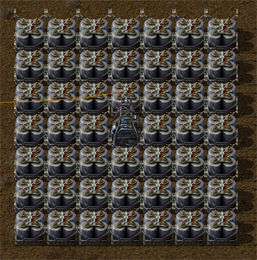Accumulator: Difference between revisions
Jump to navigation
Jump to search
No edit summary |
m Added 2 new usage suggestions |
||
| Line 20: | Line 20: | ||
* May be used to provide limited amount of power (multiples of maximum charge rate) to a section of the grid | * May be used to provide limited amount of power (multiples of maximum charge rate) to a section of the grid | ||
* Produces light when charging and discharging | * Produces light when charging and discharging | ||
* Can act as a emergency backup for your base in case of blackout, until main power supply is restored | |||
* Can act as a "surge protector" (if power usage of one device exceeds production for a few seconds or so, the basic accumulator will compensate for this and provide power to the grid until said device shuts down or requires a lesser power requirement) | |||
== See also == | == See also == | ||
Revision as of 03:00, 17 November 2014
The Basic accumulator stores a limited amount of energy when available production exceeds demand, and releases it in the opposite case. The basic accumulator stores up to 5 MJ of energy. Charge/Discharge rate is 300 kW maximum.
| Recipe: | + + => |
| Total raw: | |
| Maximum capacity: | 5 MJ |
| Charge/discharge rate: | 300 kW |
| Req. Technology: | Electric energy accumulators 1 |
See How to switch off steam engines in the night, when enough accumulator capacity is available?
- When discharged above maximum speed by multiple unconnected poles, will distribute energy unequally (some may get 100% demand, others 0%)
- May be used to provide limited amount of power (multiples of maximum charge rate) to a section of the grid
- Produces light when charging and discharging
- Can act as a emergency backup for your base in case of blackout, until main power supply is restored
- Can act as a "surge protector" (if power usage of one device exceeds production for a few seconds or so, the basic accumulator will compensate for this and provide power to the grid until said device shuts down or requires a lesser power requirement)
See also
Examples
